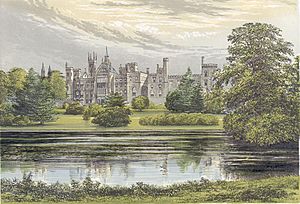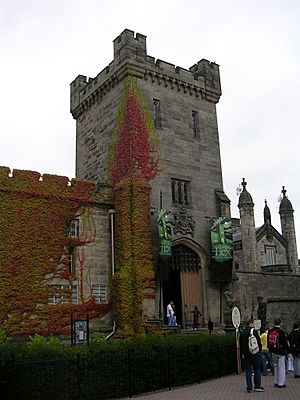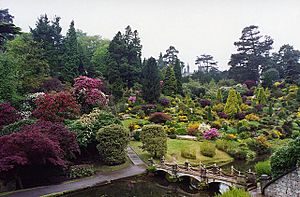History of Alton Towers facts for kids
Quick facts for kids Alton Towers |
|
|---|---|

Alton Towers from Morris's Seats of Noblemen and Gentlemen (c.1880)
|
|
| Alternative names | Alton Abbey |
| General information | |
| Type | Stately Home |
| Architectural style | Gothic Revival |
| Location | Alton, Staffordshire |
| Coordinates | 52°59′9.89″N 1°53′36.30″W / 52.9860806°N 1.8934167°W |
| Current tenants | Merlin Entertainments |
| Completed | 1850 |
| Opened | 1855 as a Gardens 1980 as a Theme Park |
| Renovated | Ongoing |
| Owner | Alton Towers Resort |
| Landlord | Merlin Entertainments |
Alton Towers is a famous place in Staffordshire, England. It started as a large country estate and was once the home of the important Earls of Shrewsbury. Today, it is one of the biggest theme parks in the United Kingdom. People have lived in the area around Alton Towers for over a thousand years. Over time, the site changed from a strong fort to a castle, and then to a grand country house.
Contents
Early History of Alton Towers
The land where Alton Towers stands has a very long history.
Ancient Forts and Battles
Around 2,000 years ago, an Iron Age fort was built on Bunbury Hill, which is now part of the Alton Towers estate. Later, around 700 AD, a Saxon king named Ceolred of Mercia built another fortress on the hill. In 716 AD, King Ine of Wessex attacked this fort. The battle ended in a tie, but so many people died that the place was called Slain Hollow. This area later became a beautiful water garden on the estate.
From Castle to Country Home
In the 11th century, after the Normans took over England, Alton Castle was built near the River Churnet. This castle was about 1 mile from where Alton Towers is today. By the 12th century, a knight named Bertram de Verdun was given the large estate for his help in the Crusades.
Later, in 1406, Sir John Talbot became the owner when he married Maud, a daughter of the Furnivall family. Sir John Talbot became the second Earl of Shrewsbury in 1442. The original Norman castle was destroyed during the English Civil War.
In the 17th century, the old castle site was turned into a hunting lodge called Alerton. This lodge used one of the old castle towers, which you can still see today. The Talbot family used it as a summer home, while their main house was in Oxfordshire.
Alton Towers: A Grand House and Gardens

Building a Stately Home
In 1801, Charles Talbot, the 15th Earl of Shrewsbury, decided that the old Alton Castle was too broken to fix. He started building a new, grand stately home in a Gothic style on his estate. Over the next ten years, many architects helped design the house. They added rooms like a drawing room, dining room, chapel, and a huge banqueting hall. The house became twice as big and was even called Alton Abbey, though it wasn't a religious building.
In 1814, Charles and his wife moved into their new home. Then, they began to create one of the largest formal gardens in Britain. They planted over 13,000 trees and created different types of gardens, including a Dutch garden and a rock garden. The gardens in the valley had many special features. These included a Pagoda fountain and beautiful cast iron conservatories.
Completing the Vision
After the 15th Earl died in 1827, his nephew John Talbot, 16th Earl of Shrewsbury took over. He finished the gardens and the house. In 1831, his main home burned down, so he moved to Alton Towers permanently. A famous architect named Augustus Pugin designed new parts of the house, making it even bigger. The property was then officially named Alton Towers. Starting in 1839, the beautiful grounds were opened to the public at certain times of the year.
Changes and Sales
In 1852, the 16th Earl died, and his young cousin Bertram became the 17th Earl. But Bertram died just four years later at age 24. No more changes were made to the house after that. Since there was no direct heir, the ownership of Alton Towers was debated. Everything inside the house was sold off in a huge auction that lasted 29 days!
In 1857, Henry Chetwynd-Talbot became the 18th Earl of Shrewsbury and bought the Alton Towers estate two years later. To celebrate, he held a huge parade and party with 40,000 people at Alton Towers. The Chetwynd-Talbots usually lived at another house, but they stayed at Alton Towers while their main home was being rebuilt after a fire. The 19th Earl opened the grounds to the public to help raise money for repairs.
In the 1890s, the 20th Earl, Charles Chetwynd-Talbot, started the tradition of summer festivals at Alton. People came to see fireworks, balloon festivals, clowns, and even exhibitions of old instruments of torture. Later, the Earl and Countess separated, and the house began to fall apart because the Earl didn't pay for its care. In 1918, the Earl decided to sell most of the estate.
Public Ownership of the Estate
In 1924, a group of local business people bought the remaining part of the estate and the house. They formed a company called Alton Towers Limited. Even though the house's contents were sold, the gardens were fixed up and stayed open to the public. Parts of the house were even turned into cafés and restrooms.
During World War II, the army used Alton Towers as a training center for officers. The gardens were closed to the public until 1951. Many people thought the army damaged the building, but this isn't true. Most of the damage happened before the war. The family who owned most of the shares sold off parts of the house, like wood, plaster, and even the lead from the roof. This allowed water to get in and ruin the building.
Alton Towers Theme Park
Early Attractions
In the 1950s, Alton Towers Limited started to open parts of the grounds to the public again. A small miniature railway was built in the grounds, which ran until 1997. Four years later, a large indoor model railway was opened in the old chapel. This model railway was huge, with hundreds of meters of track and many trains. Visitors had to pay extra to see it. In 1993, the chapel was restored, and the model railway was sold.
During the 1960s and 1970s, the grounds were developed into a bigger visitor attraction. There was a boating lake, a chairlift, and a small fair behind the ruins of the main house. Concrete floors were put into the Alton Towers house so people could walk through it. The building was officially protected as a Grade II historic site.
Becoming a Major Theme Park
In 1973, a wealthy property developer named John Broome bought control of Alton Towers. He began to transform it into the modern theme park we know today. He added many permanent rides and developed different areas of the grounds. In 1978, the newly restored sunken gardens were even featured in TV commercials!
Alton Towers truly became a major theme park in 1980. That year, they installed The Corkscrew rollercoaster, the Pirate Ship, and the Alpine Bobsled ride. In 1981, Talbot Street, the park's first themed area, opened. The Log Flume was also built near the boating lake. In 1984, the park's second rollercoaster, The Black Hole, arrived. Throughout the 1980s, more and more rides and themed areas were added.
In 1990, The Tussauds Group bought the park. This led to a period of huge growth, with many big attractions and new areas being built. These included dark rides like The Haunted House (1992) and Toyland Tours (1994). Thrill rides like Nemesis (1994), Oblivion (1998), and Air (now called Galactica) (2002) also opened. A hotel complex was added in 1996.
In 2005, Alton Towers was bought by Dubai International Capital (DIC). Then, in 2007, Merlin Entertainments bought The Tussauds Group, which included Alton Towers. Today, Merlin Entertainments operates the park, leasing it from an investment firm called Prestbury.
Images for kids




